Deutsch: Bizeps / Español: Bíceps / Português: Bíceps / Français: Biceps / Italiano: Bicipite
Bicep in the fitness context is a muscle located on the front part of the upper arm. It is known for its two-headed structure that extends from the shoulder to the elbow. The bicep is primarily responsible for the flexion of the elbow and the supination of the forearm, making it a key muscle for many upper body movements.
Description

The bicep plays a crucial role in various exercises and functional movements in fitness. It consists of two parts: the long head and the short head. These parts originate from different points on the Scapula and merge to form a single muscle that attaches to the radius bone in the forearm. The primary function of the bicep is to facilitate the Bending of the elbow and the rotation of the forearm, which are essential for lifting, pulling, and various daily activities.
Strengthening the biceps is a common goal in fitness routines due to their prominent role in arm Aesthetics and upper body strength. Exercises targeting the biceps, such as bicep curls, chin-ups, and hammer curls, are integral to many workout programs. Proper training of the biceps can enhance overall arm strength, improve muscle tone, and support other compound movements like rows and deadlifts.
Historically, the bicep has been a symbol of strength and physical fitness, often highlighted in bodybuilding competitions and fitness culture. Understanding the anatomy and function of the bicep helps in designing effective workout routines and preventing injuries associated with improper form or overtraining.
Special Considerations
When training the bicep, it's important to focus on both the long and short heads to achieve balanced muscle development. Additionally, incorporating exercises that vary the grip and angle can help target the muscle more effectively. Stretching and proper warm-up are essential to avoid strains and injuries.
Application Areas
Bicep training is applicable in various areas of fitness and sports, including:
- Bodybuilding: For muscle hypertrophy and definition.
- Strength Training: To enhance upper body strength and support compound lifts.
- Functional Fitness: To improve everyday movements and physical tasks.
- Rehabilitation: For recovering from injuries and restoring muscle function.
- Sports Performance: In sports that require strong arm movements, such as climbing, boxing, and swimming.
Well-Known Examples
Notable exercises that target the bicep include:
- Bicep Curls: Using dumbbells or a barbell, performed with palms facing up.
- Chin-Ups: A bodyweight exercise where the palms face the body as you pull yourself up.
- Hammer Curls: Similar to bicep curls but with palms facing each other, targeting the brachialis muscle as well.
- Preacher Curls: Performed on a preacher bench to isolate the bicep and minimize cheating.
Treatment and Risks
Overtraining or improper technique can lead to injuries such as bicep Tendonitis or muscle strains. It’s crucial to use correct form, avoid excessive weights, and include adequate rest and recovery in your fitness regimen. In case of injury, treatments might include rest, ice, compression, Elevation (RICE), and physical therapy.
Similar Terms
- Triceps: The muscle located at the back of the upper arm, responsible for arm extension.
- Forearm Flexors: Muscles involved in bending the wrist and fingers.
- Deltoids: Shoulder muscles that play a role in arm movement.
Summary
The bicep is an essential muscle for upper body strength and functionality, frequently targeted in fitness routines for both aesthetic and performance benefits. Understanding its anatomy and function can help in designing effective workouts and preventing injuries.
--
Related Articles to the term 'Bicep' | |
| 'Humerus' | ■■■■■■■■■■ |
| Humerus in the fitness context refers to the long bone in the upper arm that extends from the shoulder . . . Read More | |
| 'Shoulder blade' | ■■■■■■■■■ |
| Shoulder blade: The shoulder blade (also known as the scapula) is a flat, triangular bone located on . . . Read More | |
| 'Deltoid' | ■■■■■■■■ |
| Deltoid is a large, triangular muscle located on the uppermost part of the arm and the top of the shoulder. . . . Read More | |
| 'Spine' | ■■■■■■■ |
| Spine refers to the vertebral column, a critical anatomical structure in the human body, particularly . . . Read More | |
| 'Thigh bone' | ■■■■■■■ |
| Thigh bone (Femur) is the longest and strongest bone in the human body. In the fitness context, the thigh . . . Read More | |
| 'Chest' | ■■■■■■■ |
| Chest in the fitness context refers to the group of muscles located in the upper front part of the torso . . . Read More | |
| 'Pectoralis major' | ■■■■■■■ |
| Pectoralis major: The pectoralis major is a large, fan-shaped muscle located on the chest. It plays a . . . Read More | |
| 'Shoulder' | ■■■■■■ |
| Shoulder: In fitness, the shoulder refers to the complex joint that connects the upper arm (humerus) . . . Read More | |
| 'Latissimus dorsi' | ■■■■■■ |
| Latissimus dorsi is a large, flat muscle on the back that stretches to the sides, behind the arm, and . . . Read More | |
| 'Triceps' | ■■■■■■ |
| Deutsch: Trizeps / Español: Tríceps / Português: Tríceps / Français: Triceps / Italiano: Tricipiti . . . Read More | |
